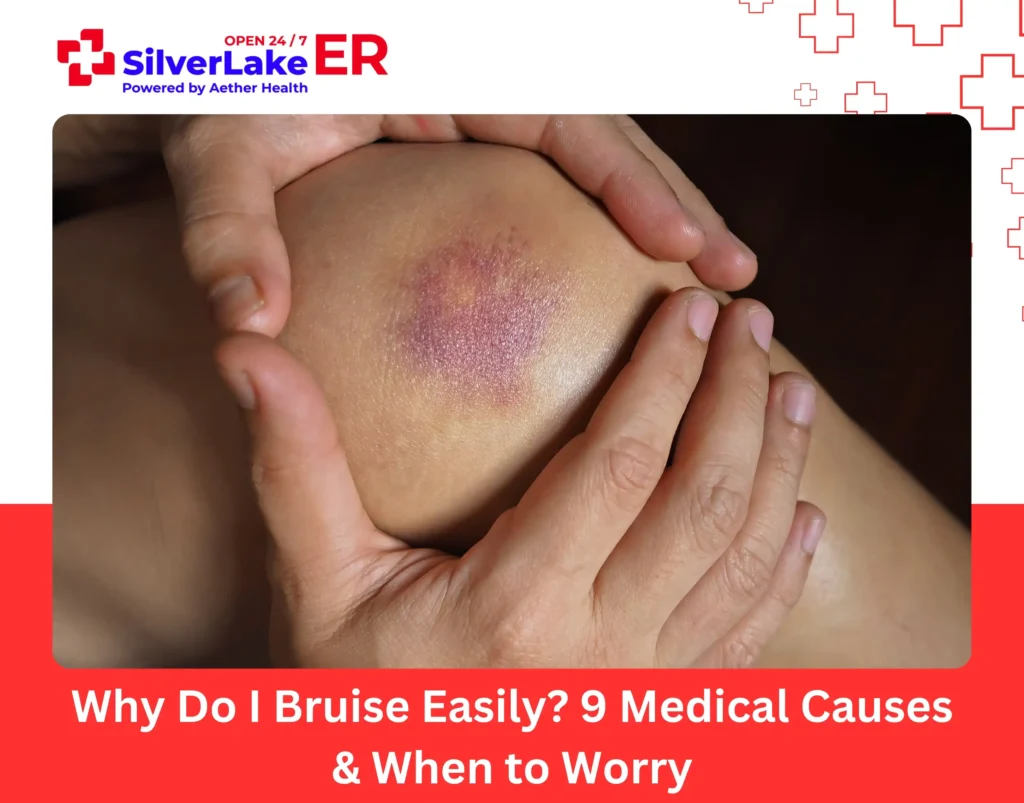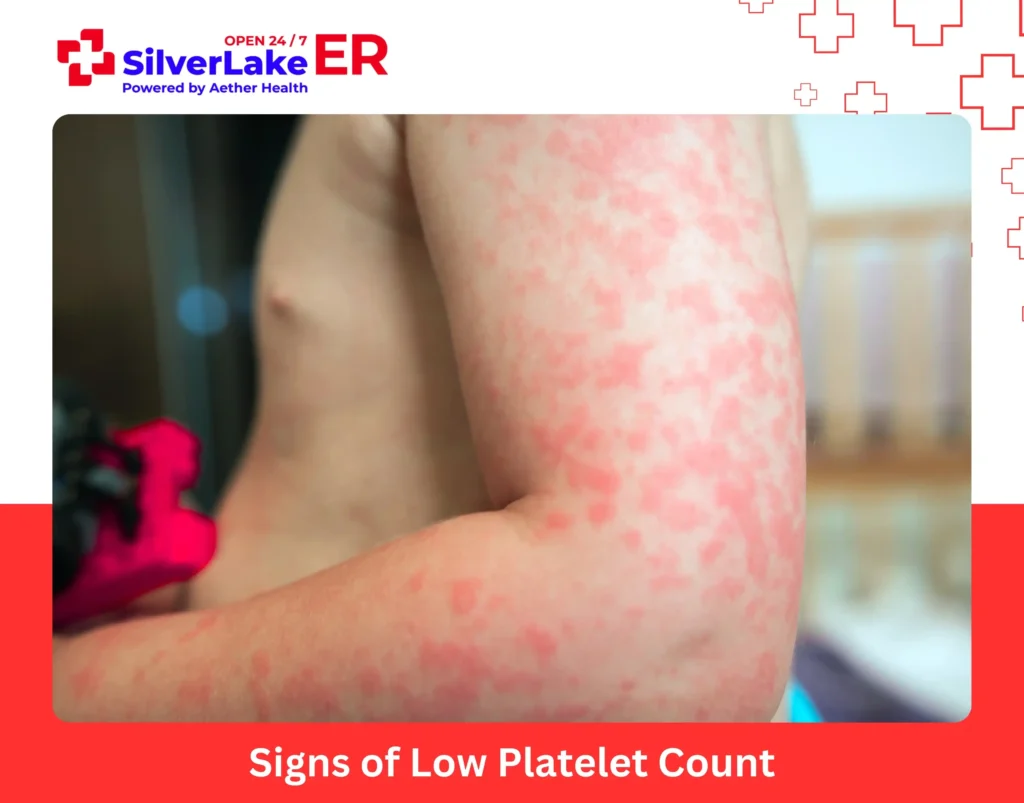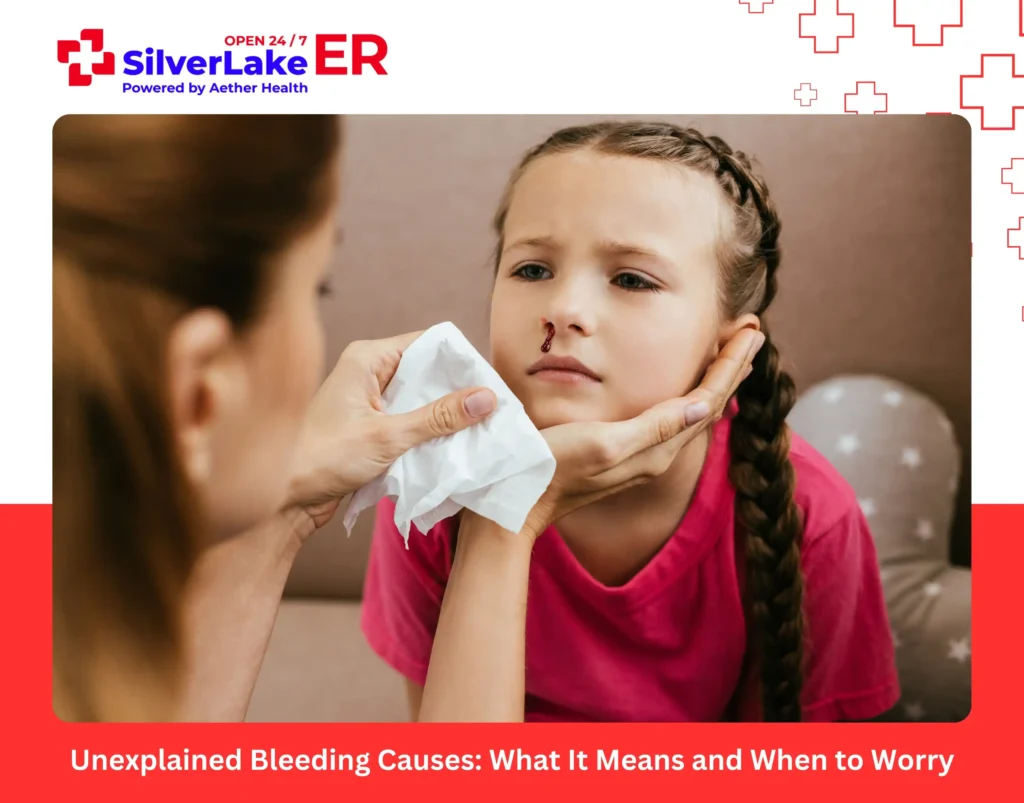Finding unexplained bruises on your arms or legs raises immediate questions. Why do I bruise easily when others don’t seem to develop these marks from similar activities?
Easy bruising affects millions of people, particularly women and older adults. While occasional bruises from bumps or falls are normal, frequent unexplained bruising may signal underlying health issues like blood disorders, medication side effects, and nutritional deficiencies, requiring attention.
This article explores easy bruising, its causes, and how you can prevent it.
What Does It Mean to Bruise Easily?
A bruise, medically called a contusion, forms when small blood vessels under the skin (capillaries) break due to impact or pressure. The leaked blood gets trapped under the skin, creating a visible discoloration. This is typically blue, purple, or black, that changes color as it heals. Bruises can occur from obvious injuries, like bumping into something or from minor trauma that you might not even notice.
Abnormal vs Normal Bruising
Normal bruising occurs on exposed areas like your shins, arms, or thighs after noticeable impacts. Abnormal bruising appears frequently with minimal trauma, develops in protected areas like your back or abdomen, or takes unusually long to heal.
Key warning signs include bruises that appear without any remembered injury, multiple bruises in various healing stages, or bruising accompanied by other symptoms like fatigue or unusual bleeding.
Why Do I Bruise Easily? 9 Common Causes
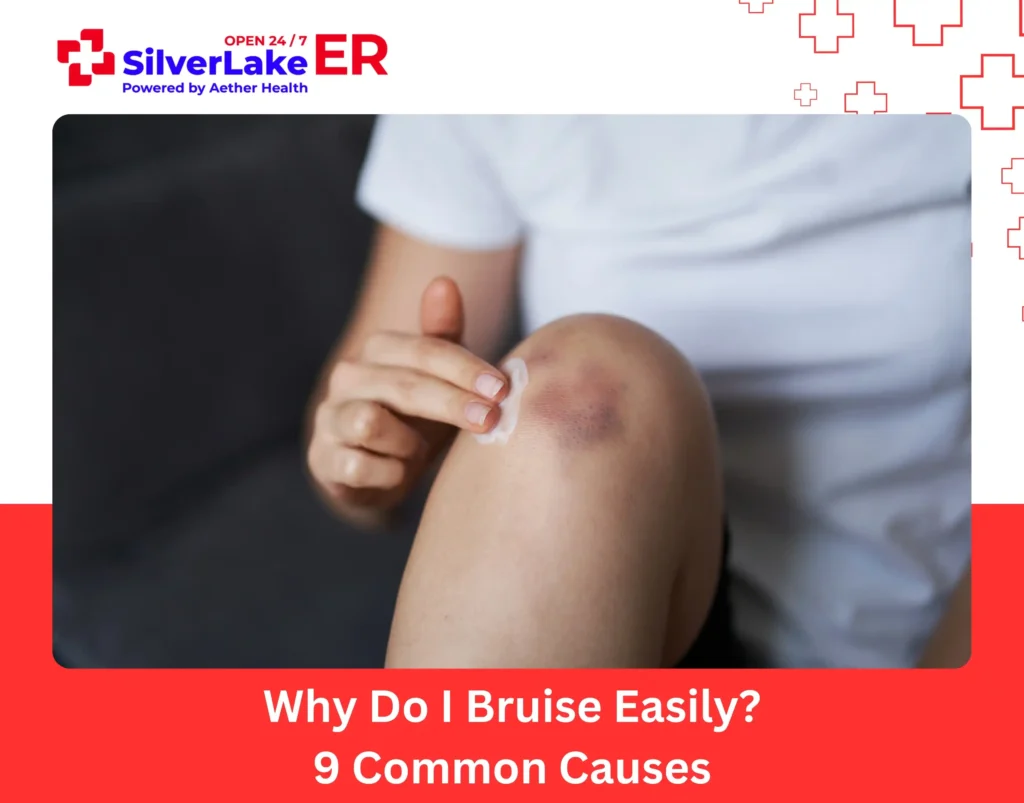
Bruising easily can result from various causes, ranging from harmless age-related changes to serious medical conditions. Let’s understand the common triggers to help you determine whether your bruising warrants medical attention.
1. Aging and Skin Thinning
We have a protective fat layer beneath the blood vessels that protects us from any trauma. As you age, this layer thins out, making blood vessels more fragile. This makes older adults more likely to sustain bruises from minor bumps that wouldn’t affect younger people.
2. Senile Purpura
Senile purpura appears as dark purple or red patches on forearms and hands. Unlike typical bruises, these marks don’t change color over time and result from excessive sun exposure weakening blood vessel walls. The damage accumulates over decades, making vessels so fragile they rupture from minimal contact.
While senile purpura is cosmetically concerning, it’s medically harmless and indicates chronic sun damage rather than underlying disease. However, it signals increased fragility that makes these areas prone to skin tears and injuries.
3. Medications
Certain medications increase bruising by affecting blood clotting or weakening blood vessels. Examples of such medications include:
- Blood thinners: Warfarin, aspirin, and clopidogrel reduce clotting ability
- NSAIDs: Ibuprofen and naproxen can interfere with platelet function
- Corticosteroids: Long-term prednisone use weakens skin and blood vessels
If you observe unexplained bruises following a recent medication change, consult your doctor about potential alternatives.
4. Vitamin Deficiencies
Your body needs specific nutrients to maintain healthy blood vessels and proper clotting. The following vitamin deficiencies can lead to easy bruising:
- Vitamin C: Builds collagen that strengthen blood vessel walls
- Vitamin K: Essential for effective blood clotting
- Vitamin B12 and folate: Support healthy blood cell production
Poor diet, digestive disorders, or absorption problems can lead to these deficiencies.
5. Blood Disorders
Some underlying medical conditions affecting blood clotting or the functionalities of the platelets may also result in unexplained or excessive bruising. These include:
- Clotting disorders: Hemophilia and Von Willebrand disease prevent proper blood clotting
- Low platelet count: Thrombocytopenia reduces the cells responsible for clotting
- Blood cancers: Leukemia, lymphoma, and multiple myeloma disrupt normal blood cell production
- Bone marrow disorders: Conditions affecting where blood cells are made
Blood cancers are particularly concerning because they can present as easy bruising before other symptoms appear. Leukemia crowds out healthy blood cells, while lymphoma can reduce platelet production. Unlike other causes, cancer-related bruising often worsens progressively and occurs alongside unexplained weight loss, night sweats, or swollen lymph nodes.
6. Family and Genetic History
Some people inherit a tendency toward easy bruising without having any specific disorder. If easy bruising runs in your family and medical tests rule out other conditions, genetics may be the answer.
7. Liver Disease
Your liver produces essential clotting factors that prevent excessive bleeding. When liver function becomes impaired through cirrhosis, hepatitis, or fatty liver disease, it can’t manufacture adequate clotting components, leading to easy bruising.
Liver-related bruising often appears with jaundice, abdominal swelling, or fatigue. The bruising may be more severe than expected and takes longer to heal. People with chronic alcohol use, viral hepatitis, or metabolic disorders face higher risk of liver-related clotting problems.
8. Intensive Workouts and Stress Trauma
Activities that involve heavy lifting, contact sports, or frequent bumping into objects can lead to bruises, even if you don’t remember the incident. People with physically demanding jobs or fitness routines may notice this more often.
9. Autoimmune Conditions
Autoimmune diseases like vasculitis cause inflammation that weakens blood vessel walls. When your immune system attacks healthy blood vessels, they become fragile and prone to rupture from minimal trauma.
Vasculitis-related bruising often appears as small red or purple spots that may cluster on legs. Unlike typical bruises, these marks may be accompanied by joint pain, fever, or rash. The challenge is that bruising may be the first symptom before other disease signs appear.
When Does Easy Bruising Require Medical Attention?
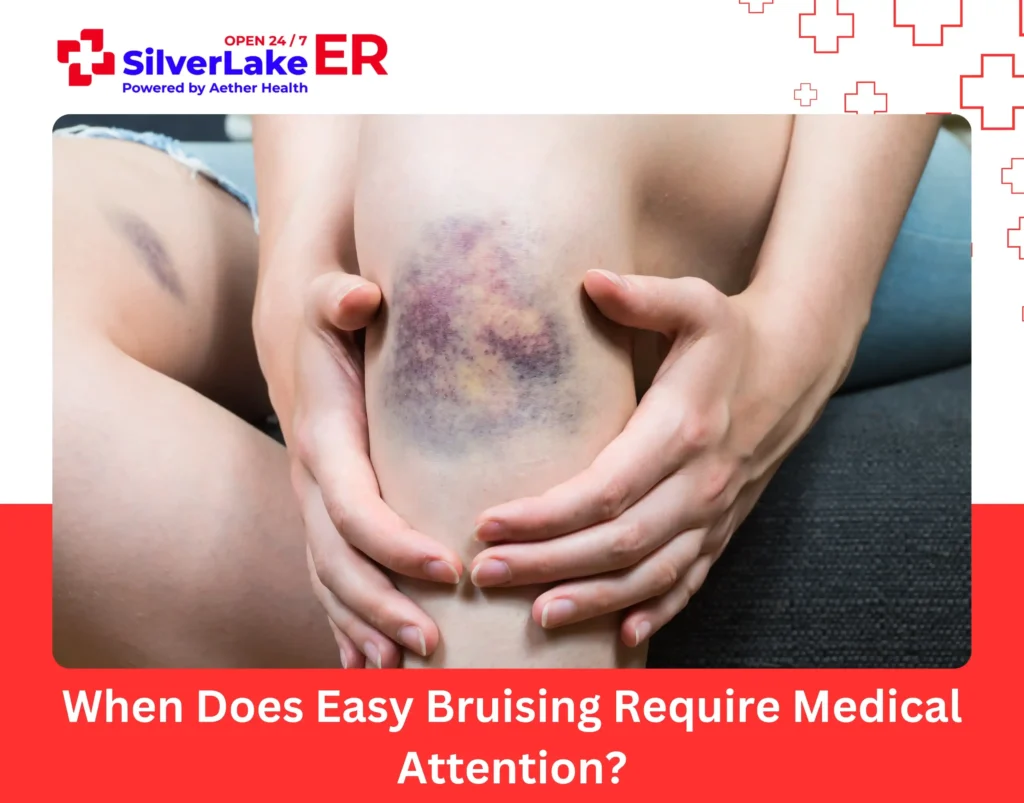
While most bruises are harmless and heal within two weeks, certain signs and symptoms indicate that easy bruising may require medical attention.
- Spontaneous bruising: Marks appearing without any remembered impact or injury
- Frequent bruising: Developing multiple bruises from minimal impact or normal daily activities
- Unusual locations: Bruising on your torso, back, or face where trauma is less likely
- Slow healing: Bruises lasting longer than two weeks or failing to change color
- Large size: Bruises bigger than a quarter or painful to a person’s touch and accompanied by swelling or hematomas
- Additional symptoms: Bruising accompanied by fatigue or unusual bleeding from nose, gums, or in urine and stool
How to Treat and Prevent Easy Bruising
The R.I.C.E. protocol helps reduce pain and swelling while accelerating healing:
1. Rest
Avoid activities that might worsen the bruised area. Give your body time to begin the healing process without additional trauma.
2. Ice
Apply an ice pack wrapped in a thin cloth for 15-20 minutes during the first 48 hours. Repeat 2-3 times daily. Cold therapy reduces blood flow to the area, minimizing swelling and numbing pain.
3. Compression
Gently wrap the area with an elastic bandage if swelling occurs. Make sure the wrap isn’t too tight; you should still feel circulation in the area.
4. Elevation
When possible, raise the bruised area above heart level. This helps reduce swelling by encouraging fluid drainage.
Preventing Future Bruising
- Improve lighting in your home to avoid bumping into furniture
- Wear protective gear during sports, physical, or outdoor activities
- Address nutritional deficiencies through diet or supplements
- Review medications with your doctor if bruising increases after starting new prescriptions
- Use moisturizer to keep skin healthy and more resilient
- Install safety features like grab bars if balance is an issue
Understanding Your Bruising Patterns
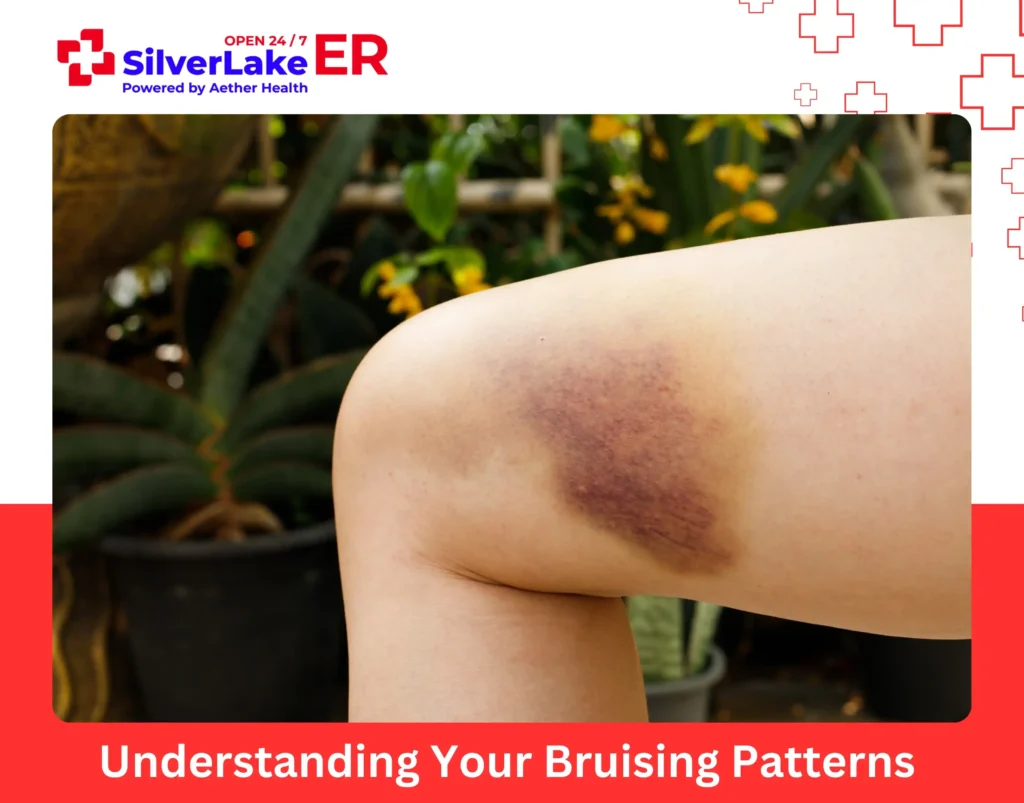
Most easy bruising stems from harmless causes like aging skin or certain medications. However, when bruising occurs alongside symptoms like fatigue, prolonged bleeding, or appears in unusual locations, it may indicate blood disorders or other medical conditions requiring evaluation.
Paying attention to your body, noting any changes, and seeking medical advice when necessary can help catch issues early and ensure your health stays on track.
Frequently Asked Questions
1. Why does a bruise change color over time?
When blood vessels break, blood seeps into surrounding tissue. As your body breaks down and absorbs this blood, the bruise changes color. Freshly oxygenated blood may make the bruise red or purple; then turning blue or green, and finally yellow over several days.
2. Why do some people bruise more easily than others?
Age-related skin thinning, medications like blood thinners or steroids, and vitamin C or K deficiencies increase bruising susceptibility. These factors weaken blood vessel integrity and disrupt normal clotting mechanisms.
3. When is easy bruising a sign of a more serious health condition?
Easy bruising becomes concerning when you develop large, unexplained bruises on your face, back, or torso without trauma. Seek medical attention if bruising occurs with prolonged bleeding, unexplained fatigue, fever, or other unusual symptoms.

